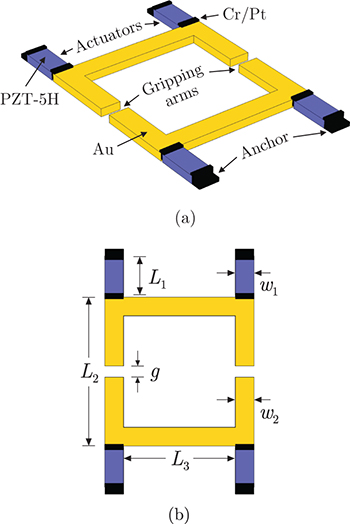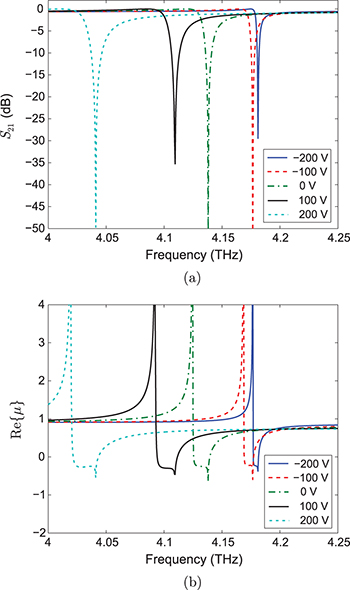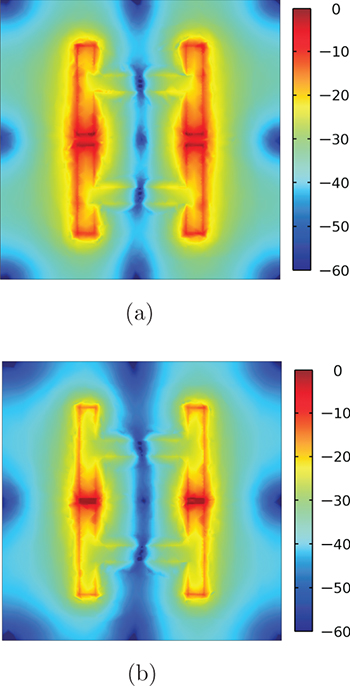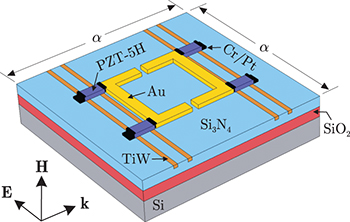Abstract
A programmable THz metamaterial, derived from the utilisation of a piezoelectric controlled microgripper as a split-ring resonator (SRR), is introduced in this paper. By applying the appropriate actuation voltage on the piezoelectric microelectromechanical systems (MEMS), a reconfigurable complex medium, offering enhanced bandwidth tunability, is attained. Several polarisation topologies are examined in order to clarify the interesting attributes of the metamaterial. Finally, thorough numerical investigations, via a robust finite element method (FEM), support the efficiency and reveal the advantages and applicability of the proposed device.
Export citation and abstract BibTeX RIS
Introduction
An inspiring feature of concurrent RF technology is related to artificially synthesised complex media, like metamaterials [1,2], which offer unique electromagnetic properties not available in nature. This extraordinary behaviour is employed in many contemporary applications, especially in the THz frequencies [3–7]. Nonetheless, their inherent lack of wide spectral bandwidths is deemed prohibitive to real-life configurations. In an effort to tackle this shortcoming, various mechanisms have been proposed, such as magnetically or thermally controlled liquid crystals, and optically reconfigurable silicon apparatuses. However, radio-frequency microelectromechanical systems (RF-MEMS) [8] are considered as the most competent devices to accomplish advanced bandwidth tunability. Amid them, thermal and electrostatic RF-MEMS, such as curved membranes, comb drives and cantilevers, have been exploited for the required response controllability [9–13]. Alternatively, a reconfigurable metamaterial, that associates the double two–hot-arm electrothermal actuator with a split-ring resonator (SRR), has been proposed [14]. These arrangements yield a tunable mu-negative (MNG) behaviour, while the MEMS device is only a part of the resonator.
In this paper, piezoelectric MEMS actuators are utilised to develop a microgripper, namely a device capable of handling objects at the scale of micrometers. The structure, so designed, is exploited to implement the SRR and sustain the MNG resonances. The proposed resonator's functionality is modified in terms of its operability. Instead of gripping objects, the microgripper acts as a resonator, whereas the movement of its arms provides the required frequency shifting and bandwidth enhancement. The proposed configuration successfully exhibits this attribute, as verified by diverse numerical simulations.
The reconfigurable THz metamaterial
The piezoelectric actuator exhibits a simple, yet rather effective, geometry in terms of displacement generation. Furthermore, this device involves low-temperature operation as well as insensitivity to ambient electromagnetic fields. A small fragment of a piezoelectric material shaped in a rectangle form and anchored at one side can be considered as a voltage-driven actuator. The actuator's principal operation is summarised in the development of piezoelectric expansion and thus displacement of the associated tip, when excited by a potential difference. An actuator of this kind is depicted in fig. 1, while four actuators are employed, together with metal strips, in order to design the proposed microgripper (also depicted in fig. 1(a)). Specifically, an electrostatic field, which generates a strain due to the piezoelectric effect, is created in each actuator. Therefore, an expansion occurs, whereas the arms are deflected towards each other, resulting in gripping procedure. On the other hand, when the bias voltage is decreased or reversed, the contraction of the MEMS devices moves away the associated arms and thus releases an object.
Fig. 1: (Colour on-line) Geometric configuration along with the design and physical parameters of the piezoelectric microgripper. (a) 3D perspective and (b) top view.
Download figure:
Standard imageThe design and physical parameters of the proposed structure, as shown in fig. 1(b) and table 1, are selected as  ,
,  ,
,  ,
,  , and
, and  . Its metal section comprises a
. Its metal section comprises a  thick gold (Au) layer, while the piezoelectric modules consist of lead zirconate titanate (PZT-5H). Additionally, an adhesive material, such as chromium/platinum (Cr/Pt) is mandatory to form the anchor areas of the actuators as well as the adhesion between the arms of the microgripper and the actuators. Based on the above aspects, a coupled electric/structural analysis is performed via the FEM approach, while the resonator is discretised into 1216 prismatic elements with 22954 degrees of freedom. The maximum tip displacement is calculated for different values of the actuation voltage, as shown in fig. 2. Furthermore, its corresponding total displacement distribution at two distinct actuation voltages, namely
thick gold (Au) layer, while the piezoelectric modules consist of lead zirconate titanate (PZT-5H). Additionally, an adhesive material, such as chromium/platinum (Cr/Pt) is mandatory to form the anchor areas of the actuators as well as the adhesion between the arms of the microgripper and the actuators. Based on the above aspects, a coupled electric/structural analysis is performed via the FEM approach, while the resonator is discretised into 1216 prismatic elements with 22954 degrees of freedom. The maximum tip displacement is calculated for different values of the actuation voltage, as shown in fig. 2. Furthermore, its corresponding total displacement distribution at two distinct actuation voltages, namely  and 200 V, is presented in fig. 3.
and 200 V, is presented in fig. 3.
Table 1:. Design parameters (in μm) of the piezoelectric microgripper and the unit cell of the reconfigurable complex medium.
| L1 | L2 | L3 | L4 | L5 | L6 | L7 | L8 | w1 | w2 | w3 | g | s1 | s2 | s3 | s4 | s5 | s6 | s7 | s8 | h1 | h2 | h3 | h4 | α |
|---|---|---|---|---|---|---|---|---|---|---|---|---|---|---|---|---|---|---|---|---|---|---|---|---|
| 2.0 | 8.0 | 6.0 | 0.5 | 0.1 | 0.1 | 0.3 | 0.1 | 1.0 | 1.0 | 0.4 | 0.6 | 2.0 | 1.0 | 1.0 | 0.4 | 0.3 | 0.2 | 0.3 | 0.1 | 5.0 | 3.0 | 3.0 | 1.0 | 18.0 |
Fig. 2: (Colour on-line) Maximum tip displacement for different values of the actuation voltage.
Download figure:
Standard imageFig. 3: (Colour on-line) Total displacement distribution (in μm) at the actuation voltage of  (a) and 200 V (b).
(a) and 200 V (b).
Download figure:
Standard imageA reconfigurable metamaterial can be designed by exploiting the aforementioned microgripper, as illustrated in fig. 4, along with its corresponding unit cell. When a certain voltage is applied, the resulting piezoelectric expansion or contraction, moves the metal parts of the structure and the gaps are shortened or enlarged, respectively. Thus, variations in actuation voltage levels introduce tunable gaps and as a consequence a programmable SRR.
Fig. 4: (Colour on-line) Geometric configuration along with the design and physical parameters of the reconfigurable, in terms of piezoelectric MEMS actuators, metamaterial. (a) The complex medium, (b) 3D perspective of the unit cell, (c) magnified detail in the vicinity of the associated actuators, (d) top view of the unit cell, and (e) cross-section of the unit cell.
Download figure:
Standard imageThe proposed device can be feasibly fabricated via a surface micromachining technique, such as the metal multi-user MEMS processes (MetalMUMPs) [15], along with some modifications to incorporate the additional materials required. Therefore, to construct the aforementioned complex medium, a silicon (Si) substrate is utilised to provide the handling support. Then, an isolation layer, like the silicon oxide (SiO2) is deposited, followed by a dielectric layer of silicon nitride (Si3N4). Moreover, two pairs of titanium tungsten (TiW) electrodes are patterned to control the actuators behaviour by applying the proper bias voltage. Next, an Au layer is deposited to shape the microgripper's arms, whereas PZT-5H is used for the development of the piezoelectric actuators. Finally, an adhesion layer of Cr/Pt is placed to set the anchors to the Si3N4 layer and guarantee the pertinent adhesion between Au and PZT-5H. In this context, the design and physical parameters of the tunable unit cell are summarized in table 1. Specifically, the cell period is set to  , while
, while  ,
,  ,
,  ,
,  , and
, and  , as depicted in the top view of the unit cell in fig. 4(d). The rest of the parameters are:
, as depicted in the top view of the unit cell in fig. 4(d). The rest of the parameters are:  ,
,  ,
,  ,
,  ,
,  , together with the thicknesses of the diverse material layers, namely,
, together with the thicknesses of the diverse material layers, namely,  ,
,  ,
,  ,
,  ,
,  ,
,  ,
,  , and
, and  , as illustrated in the detailed cross-section of the device in fig. 4(e).
, as illustrated in the detailed cross-section of the device in fig. 4(e).
Taking into account the prior geometric and physical configuration, all numerical simulations are conducted through a properly tailored FEM, whereas a parallel-plate waveguide approach is adopted to extract the S-parameters. This technique involving perfectly electric conductor (PEC) and perfectly magnetic conductor (PMC) boundary conditions constitutes an excellent approximation to model the array of the unit cells in comparison with Floquet boundary conditions. In particular, the unit cell is divided into 23412 tetrahedral elements with 152416 degrees of freedom. Also, a robust homogenisation method [16] is exploited to retrieve the constitutive effective parameters of the proposed complex materials.
Results and discussion
A detailed assessment regarding the properties of the novel controllable metamaterial in the THz frequency region is performed. Several polarisation topologies are examined to reveal the characteristics of the associated resonances.
The first topology is denoted by an impinging wave parallel to the plane of the resonators. Specifically, the magnetic field is perpendicular to the loops of the unit cells, whereas the electric field is parallel to the piezoelectric actuators, as depicted in fig. 4. The magnitude of the S21-parameter along with the real part of the effective magnetic permeability are calculated and presented in fig. 5, both for different values of the actuation voltage. These results reveal the MNG THz resonance of the complex medium as well as the ability for improved bandwidth. The frequency regions of interest are denoted in table 2, when the actuation voltage increases from  to 200 V. An enhanced tunability is accomplished, since the narrow bandwidth (BW) of 1.7 GHz, is artificially extended to
to 200 V. An enhanced tunability is accomplished, since the narrow bandwidth (BW) of 1.7 GHz, is artificially extended to  , offering an improvement of 83 times of magnification. Furthermore, two snapshots of the electric-field intensity are given in fig. 6, when the actuation voltage is
, offering an improvement of 83 times of magnification. Furthermore, two snapshots of the electric-field intensity are given in fig. 6, when the actuation voltage is  and 200 V, respectively. The maximum values are observed in the gap regions, displaying the MNG performance. Finally, a snapshot of the surface current distribution is depicted in fig. 7, when the device is actuated by 200 V. Apparently, the maximum value is obtained upon the surface of the SRR and especially the inner part of the resonator, denoting the presence of an MNG resonance. Consequently, it is promptly deduced that the prior SRR can be proven instructive in several high-frequency arrangements.
and 200 V, respectively. The maximum values are observed in the gap regions, displaying the MNG performance. Finally, a snapshot of the surface current distribution is depicted in fig. 7, when the device is actuated by 200 V. Apparently, the maximum value is obtained upon the surface of the SRR and especially the inner part of the resonator, denoting the presence of an MNG resonance. Consequently, it is promptly deduced that the prior SRR can be proven instructive in several high-frequency arrangements.
Table 2:. Spectral characteristics of the MNG resonances for the initial polarisation.
| Frequency regions | |||
|---|---|---|---|
| Actuation voltage (V) | Start (THz) | End (THz) | BW (GHz) |
| −200 | 4.1807 | 4.1813 | 0.6 |
| −100 | 4.1760 | 4.1770 | 1.0 |
| 0 | 4.1372 | 4.1389 | 1.7 |
| 100 | 4.1083 | 4.1104 | 2.1 |
| 200 | 4.0396 | 4.0424 | 2.8 |
Fig. 5: (Colour on-line) Tunable behaviour at several actuation voltages through the S21-parameter (a) and effective magnetic permeability (b).
Download figure:
Standard imageFig. 6: (Colour on-line) Electric-field snapshots of the piezoelectric controlled metamaterial unit cell, when the actuation voltage is  at 4.181 THz (a) and 200 V at 4.041 THz (b).
at 4.181 THz (a) and 200 V at 4.041 THz (b).
Download figure:
Standard imageFig. 7: (Colour on-line) Surface current density snapshot of the piezoelectric controlled metamaterial unit cell, when the actuation voltage is 200 V at 4.041 THz (arrows depict the direction and intensity of the surface current flow).
Download figure:
Standard imageThe second topology is also described by an impinging wave parallel to the plane of the resonators. However, this wave is rotated by 90° in comparison to the initial orientation. Thus, in this case the electric field is perpendicular to the piezoelectric actuators, while the magnetic field is perpendicular to the loops, as illustrated in fig. 8. The magnitude of the S21-parameter along with the real part of the effective electric permittivity are extracted and depicted in fig. 9, both for different values of the actuation voltage. These data denote the presence of an epsilon-negative (ENG) THz resonance of the complex medium as well as the capability for enhanced bandwidth. The corresponding frequency regions are presented in table 3, when the actuation voltage increases from  to 200 V. An improved tunability is attained, since the narrow bandwidth of 56.8 GHz, is artificially extended to
to 200 V. An improved tunability is attained, since the narrow bandwidth of 56.8 GHz, is artificially extended to  , offering an improvement of 253.9%. Moreover, two snapshots of the electric-field intensity are depicted in fig. 10, when the actuation voltage is
, offering an improvement of 253.9%. Moreover, two snapshots of the electric-field intensity are depicted in fig. 10, when the actuation voltage is  and 200 V, respectively. The maximum values are located in the regions of the gaps and especially in the half part of the resonator, thus displaying the ENG behaviour. Additional evidence of this performance is drawn from the surface current distribution snapshot, presented in fig. 11, when the device is actuated by 200 V. It becomes apparent that the maximum value is observed only upon the half portion of the SRR. In this manner, the unit cell acts as a metal wire, sustaining a clear ENG resonance. Therefore, it can be concluded that the developed SRR may constitute a beneficial component in an assortment of high-frequency setups.
and 200 V, respectively. The maximum values are located in the regions of the gaps and especially in the half part of the resonator, thus displaying the ENG behaviour. Additional evidence of this performance is drawn from the surface current distribution snapshot, presented in fig. 11, when the device is actuated by 200 V. It becomes apparent that the maximum value is observed only upon the half portion of the SRR. In this manner, the unit cell acts as a metal wire, sustaining a clear ENG resonance. Therefore, it can be concluded that the developed SRR may constitute a beneficial component in an assortment of high-frequency setups.
Table 3:. Spectral characteristics of the ENG resonances for the alternative polarisation.
| Frequency regions | |||
|---|---|---|---|
| Actuation voltage (V) | Start (THz) | End (THz) | BW (GHz) |
| −200 | 4.1842 | 4.2229 | 38.7 |
| −100 | 4.1772 | 4.2263 | 49.1 |
| 0 | 4.1331 | 4.1899 | 56.8 |
| 100 | 4.1001 | 4.1598 | 59.7 |
| 200 | 4.0253 | 4.0832 | 57.9 |
Fig. 8: (Colour on-line) Topology for an alternative polarisation of the reconfigurable, in terms of piezoelectric MEMS actuators, unit cell.
Download figure:
Standard imageFig. 9: (Colour on-line) Tunable behaviour for the alternative polarisation at several actuation voltages in terms of the S21-parameter (a) and effective electric permittivity (b).
Download figure:
Standard imageFig. 10: (Colour on-line) Electric-field snapshots for the alternative polarisation of the piezoelectric controlled metamaterial unit cell, when the actuation voltage is  at 4.203 THz (a) and 200 V at 4.051 THz (b).
at 4.203 THz (a) and 200 V at 4.051 THz (b).
Download figure:
Standard imageFig. 11: (Colour on-line) Electric-field snapshots for the alternative polarisation of the piezoelectric controlled metamaterial unit cell, when the actuation voltage is 200 V at 4.051 THz (arrows depict the direction and intensity of the surface current flow).
Download figure:
Standard imageOverall, the featured configuration is deemed advantageous in terms of providing continuous tuning of the resonances, when compared with electrostatically reconfigurable metamaterials [10,11]. Note that the latter can only shift the resonance with discrete steps due to snap-down effects of the associated electrostatic MEMS components. Furthermore, the structure, so developed, exhibits low power consumption in comparison with electrothermally programmable complex media [14], since there is no need for any current flow related to biasing purposes. It should be, lastly, stressed that the controllable metamaterial presents a different performance, when the polarisation of the impinging wave is modified. The numerical assessment of the device denotes that the central frequency of the resonances is shifted, while the corresponding quality factor is altered. Moreover, in some topologies, the essence of each resonance is reconfigured between ENG performance and MNG one. This observation regarding anisotropy is deemed crucial in designing programmable metamaterials and associated apparatuses, such as programmable antennas, modulators, and filters.
Conclusions
The exploitation of contemporary piezoelectric MEMS actuators for the consistent design of a novel microgripper, which exhibits the behaviour of a reconfigurable metamaterial, has been presented in this paper. In order to reveal its possible realisation renditions, different polarisation arrangements of the structure along with a viable fabrication procedure have been thoroughly investigated. Finally, a set of efficient FEM simulations has accurately identified the properties and the advantages of the proposed device, which enables advanced bandwidth tunability and, as a consequence, potential applications in a variety of high-end THz implementations.
Acknowledgments
This research has been cofinanced by the European Union (European Social Fund —ESF) and Greek national funds through the Operational Program "Education and Lifelong Learning" of the National Strategic Reference Framework (NSRF) —Research Funding Program: Aristeia I. Investing in knowledge society through the European Social Fund.
This article has been submitted by participants at the META'14 event in Singapore in May 2014. EPL supports the META series by providing annual sponsorship. The scientific content has been peer reviewed under the same guidelines and criteria as all other EPL letters.
















